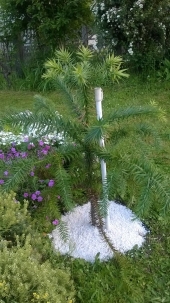
 1
1




![Filename: 14724455_1768032680130855_4110940239596171684_n.jpg
Description: The Araucaria Angustifolia world record holder for cone production, 674 in a single year!. [Thumbnail for 14724455_1768032680130855_4110940239596171684_n.jpg]](/t/60818/a/45619/thumb-14724455_1768032680130855_4110940239596171684_n.jpg)
![Filename: 14732408_1768603190073804_2722538223153549270_n-1.jpg
Description: A different view of the same tree. [Thumbnail for 14732408_1768603190073804_2722538223153549270_n-1.jpg]](/t/60818/a/45620/14732408_1768603190073804_2722538223153549270_n-1.jpg)
![Filename: 20150416_111506.jpg
Description: A large fruiting Angustifolia showing the genetic diversity of this species. [Thumbnail for 20150416_111506.jpg]](/t/60818/a/45621/20150416_111506.jpg)




 1
1




-
 2
2




![Filename: 1.jpg
Description: The grafting process (sorry its in portuguese lol) [Thumbnail for 1.jpg]](/t/60818/a/45628/1.jpg)
![Filename: pinhao0025-665x407.jpg
Description: Mr. Wendling with a low fruiting grafted female. [Thumbnail for pinhao0025-665x407.jpg]](/t/60818/a/45629/pinhao0025-665x407.jpg)




Sam Williams wrote: There is a man Called Ivar Wendling in south America who has perfected a grafting technique that allows you to have very low fruiting (within reach) Angustifolia trees by taking bark patch graft from epicormic shoots high up in fruiting age trees and grafting it onto small saplings, I don't see why this wouldn't work for Bunya's and is one of the things I want to try out.
-
 2
2









-
 1
1




-












Sam Williams wrote:I also now understand how to have a small fruiting araucaria garden tree (around 6') without any pruning. from graft to fruit can be as little as 4 years, maybe even sooner if you grafted onto selected faster growing seedlings.
-




 1
1








-










Chris Holcombe wrote:Is it true that they can take up to 30yrs to yield? I want to plant a few but that’s a super long wait for a harvest. Are there any superior selected varieties out there?
-






 1
1












Examine your lifestyle, multiply it by 7.7 billion other ego-monkeys with similar desires and query whether that global impact is conscionable.
 2
2
















Richard Forest wrote:Hi Windy,
Araucaria can be propagated via tissue culture. Wollemia Nobiliis, the Wollemi Pine was an ancient tree found in a deep gorge in the Blue Mountains by Park Ranger David Noble. The tree survived millions years and specifically the last 50,000 years of destructive human burning here in Australia. It is believed, that due to an extreme lack of genetic diversity in the remaining plants, destructive human fire stick farming/mosaic burning and natural fires reduced this population to maybe one or two individual trees. Due to the valuable nature of this tree to tree enthusiasts and collectors, the material was propagated extensively via tissue culture and the resulting trees sold all over the world to satisfy demand.
Of the family Araucariaceae(in the order Pinales) you have 3 remaining genuses(Araucaria, Agathis, Wollemia).
-In the genus Araucaria there is the Bunya Pine, Hoop Pine, Parana Pine, Monkey Puzzle Tree, Klinki Pine from PNG, Norfolk Island Pine, and 15 highly threatened species from New Caledonia.
-In the genus Agathis, which are commonly known as Kauri Pine, Australia has 3(Atropurpurea, Microstachya and Robusta), Australis in NZ, and there are many others(22 species in total)in the Southern Hemisphere.
-In the genus Wollemia, there is one. Wollemia Nobilis, the Wollemi Pine, a living fossil that survived the constant burning created by destructive humans.
Agriculture is around 12,500 years old.
Homo Sapiens is around 200,000 years old.
Primates are around 50 million years old.
These trees are 240 million years old, before bees, birds, eucalypts or flowers....before the emergence of almost anything we know or recognise in our current short lives.
These trees oxygenated the earth from 0.16% oxygen in the air to levels that would allow our emergence and eventual destruction of these same trees(and ourselves).
https://www.abc.net.au/radionational/programs/offtrack/australian-rainforest-woods/9448170
I hope you find researching these trees interesting. They really are an ancient giant, and such a useful plant in the myriad benefits that they could provide us. Unfortunately, we are too short sighted to plant them en masse, eg in a strip farming agroforestry scenario. They collect fog and precipitation on their leaves due to their high leaf area and return that massive amount of water back to the soil, helping us in every possible way. They also limit evaporation in dry areas, of which Australia is one of the driest on the planet, and provide a massive nut crop every 3 years. When will we ever learn?? Only until it's too late I imagine.








 1
1








 1
1








Caroline Mello wrote:Hello, I'm from Brazil in the native region of Paraná pine (Araucaria angustifolia). I'm starting to research the monkey puzzle tree (Araucaria araucana). My advisor developed the grafting technique for the production of pine nuts from 7 years (orthotropic branches) and 4 years (plagiotropic branches). I would like to know if someone has succeeded in grafting using the Zanette technique, 2011 for the Monkey puzzle tree, even if by interspecific grafting.
https://www.researchgate.net/deref/http%3A%2F%2Fdx.doi.org%2F10.1590%2FS0100-29452011000400040
Thanks
![Filename: abe2.jpg
Description: [Thumbnail for abe2.jpg]](/t/60818/a/216152/abe2.jpg)








 1
1




 1
1





|
Bring out your dead! Or a tiny ad:
Support permies and give beautiful gifts to gardeners: permaculture playing cards.
https://gardener-gift.com/
|






